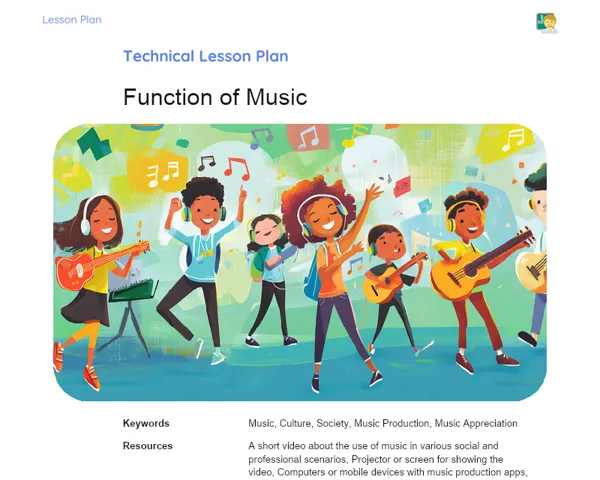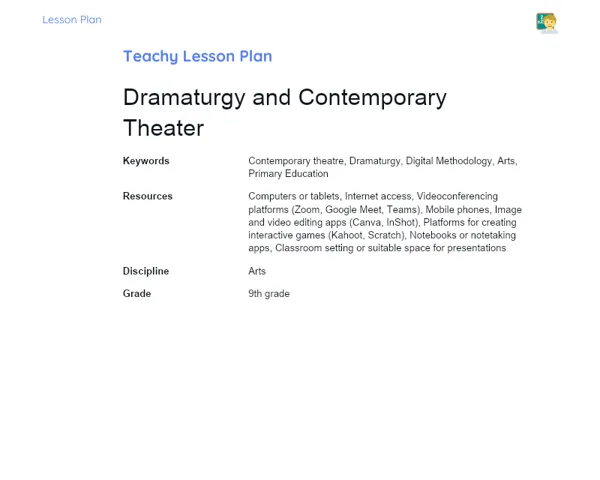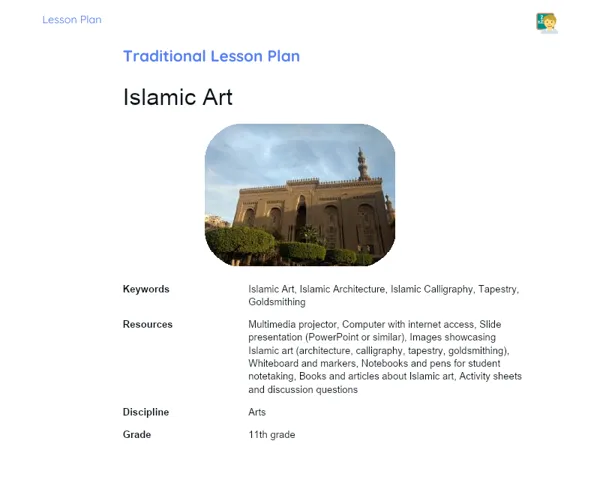Lesson Plan | Lesson Plan Iteratif Teachy | Theater
| Keywords | Theatre, Arts, Digital Methodology, 4th Grade, Practical Activities, Content Production, Creativity, YouTube, Instagram, Gamification, Script, Set Design, Costumes, Performance, Collaboration, Artistic Expression, History of Theatre, Theatrical Elements, Social Media, Video, Storytelling |
| Resources | Smartphones with cameras, Internet access, Computers or tablets for video editing, Video editing apps (e.g., YouTube Studio, Canva), YouTube account (for video publication), Instagram account (for story publication), Gamification platforms (e.g., Kahoot!, Quizizz), Paper and pencils (for scripts and storyboards), Basic props and costumes (which can be improvised by students) |
| Codes | - |
| Grade | 4th grade |
| Discipline | Arts |
Goal
Duration: (10 - 15 minutes)
This stage aims to introduce students to the rich world of theatre, helping them grasp its relevance and diversity. A solid foundational understanding is essential for students to engage meaningfully in later practical activities, armed with a contextualised and in-depth grasp of the subject.
Goal Utama:
1. Understand the concept of theatre and its historical and cultural significance.
2. Identify the various forms and contexts of theatre within our society.
3. Recognize the key elements of theatre, such as set design, costumes, scripts, and performance.
Goal Sekunder:
- Ignite students' enthusiasm for artistic and cultural expression.
- Encourage a critical appreciation of the performing arts.
Introduction
Duration: (10 - 15 minutes)
This stage's goal is to immerse students in the world of theatre, helping them appreciate its relevance and diversity. This foundational understanding is vital for them to enthusiastically partake in practical tasks with contextualised knowledge.
Warming Up
Kick-off to the Topic: Theatre, one of our oldest artistic expressions, utilises elements like set design, costumes, scripts, and performance to weave stories and convey emotions. Let's start our lesson by asking students to whip out their phones and dig up an interesting fact about theatre. They can search for the history of theatre, quirky trivia about renowned plays, or insights into famous actors and directors. Give them a few moments for this research, then have them share their discoveries with the class.
Initial Thoughts
1. What did you find most surprising about theatre during your research?
2. How is theatre different from other entertainment forms, like movies and TV shows?
3. Have you ever gone to see a play? What was that experience like?
4. Why do you think theatre still holds importance in today's society?
5. _What emotions and messages do you think theatre can convey?
Development
Duration: (75 - 85 minutes)
This stage aims to provide students with a practical and creative engagement with theatre, utilising digital technologies as learning instruments. The suggested activities encourage collaboration, innovation, and the application of acquired knowledge in a fun and contextualised manner.
Activity Suggestions
Activity Recommendations
Activity 1 - Digital Theatre: Creating Plays for YouTube 🎭
> Duration: (60 - 70 minutes)
- Goal: Enhance theatre skills and video production, fostering creativity and teamwork.
- Deskripsi Activity: Students will craft a short theatre play to be filmed and uploaded to YouTube. They will decide on a theme, write the script, rehearse, and finally film the play using their smartphones. Beyond honing their theatre skills, they'll gain insight into digital content production.
- Instructions:
-
Divide the class into groups of up to 5 students.
-
Have them select a theme or story they'd like to depict.
-
Assist them in writing a script no longer than 5 minutes.
-
Allocate 10-15 minutes for students to rehearse their lines and movements.
-
Use smartphones to film the presentation, encouraging different angles and filming techniques.
-
Once recorded, each group can edit their video using simple online tools like YouTube Studio or free video editing apps.
-
Request that the videos be uploaded to a class-specific YouTube channel (ensuring the safety and privacy of the students).
-
Wrap up with a screening of the videos, where each group presents and discusses their creative process.
Activity 2 - Storytelling on Social Media: A Theatre Tale 📱
> Duration: (60 - 70 minutes)
- Goal: Foster creativity and digital storytelling skills while exploring theatre in a contemporary and interactive manner.
- Deskripsi Activity: Students will devise a series of Instagram stories to narrate the tale of a famous play. They'll utilise images, short videos, text, and audio to tell the story in an engaging and imaginative manner.
- Instructions:
-
Form groups of up to 5 students.
-
Each group should pick a famous play (e.g., Romeo and Juliet, The Wizard of Oz).
-
Have them dive into research about the play's story and characters.
-
Students are to create a storyboard outlining the sequence of posts they'll make.
-
Use a content creation app for Instagram (like Canva or directly on Instagram) for students to produce their stories.
-
Encourage the incorporation of interactive elements like polls, questions, videos, and visual effects.
-
Each group should share their stories on a dedicated class Instagram account or present them directly from their group's account.
-
To end, hold a class discussion to celebrate the different creative methods utilised by each group.
Activity 3 - Scene Game: Gamifying Theatre 🎯
> Duration: (60 - 70 minutes)
- Goal: Merge theatre knowledge with game dynamics, encouraging playful and collaborative learning.
- Deskripsi Activity: Students will utilise a gamification platform (like Kahoot! or Quizizz) to formulate a quiz game on theatre. Questions may cover historical facts, types of theatre, scene elements, and trivia about iconic plays.
- Instructions:
-
Form groups of up to 5 students.
-
Have each group select an aspect of theatre to focus on (history, types of theatre, scenic elements, etc.).
-
Guide them in researching and crafting a series of questions and answers related to their chosen theme.
-
Employ a gamification platform (like Kahoot! or Quizizz) for groups to input their questions.
-
Each group should organise their questions for an engaging and challenging game.
-
After creating their quizzes, allow each group to participate in the quiz designed by another group to promote knowledge sharing.
-
Conclude with a discussion reflecting on what was learnt during the activity and how gamification can serve as a fun educational tool.
Feedback
Duration: (15 - 20 minutes)
🎤 Purpose: This stage aims to cement learning through reflection and sharing experiences, promoting self-critique and appreciation of teamwork. This final discussion enriches students' comprehension and provides constructive feedback that supports their ongoing development.
Group Discussion
💬 Group Discussion: Foster a discussion where students can share their experiences and insights. Begin by thanking everyone for their contributions and underscore the value of exchanging ideas. Use the following prompts to guide the conversation:
- Introduction: "Now that we've wrapped up our activities, let's share what we've learned and how we felt throughout the process."
- Experience Sharing: "Each group can relay their activity experience, challenges faced, and any innovative solutions approached."
- Discussion of Relevant Points: "What were the most fascinating aspects you discovered about theatre?"
- Closing: "In what ways do you think this experience might be applicable outside the classroom?"
Reflections
1. 🎭 What was your biggest takeaway from creating and sharing your digital theatre pieces? 2. 📱 How did utilising social media and digital platforms enhance your understanding of theatre? 3. 🤔 What would you change if you had another chance to run this activity?_
Feedback 360º
🔄 360° Feedback: Instruct students to give constructive feedback within their groups. Clarify that feedback should be framed positively, focusing on strengths and areas for enhancement. Use the following model to direct the feedback exchange:
- Positive Points: "What was executed well?"
- Areas for Improvement: "What could be improved?"
- Suggestions: "Would it be alright if I suggested something for improvement?"
- Conclusion: "How can we incorporate these improvements in our future activities?"
Conclusion
Duration: (10 - 15 minutes)
🎤 Purpose: This concluding stage serves to reinforce the learning outcomes from the class, linking the material discussed to the real world and contemporary contexts. It allows students to consider the importance and practical applications of what they've learned, concluding the lesson with a comprehensive and contextualised understanding of theatre.
Summary
🌟 Fantastic Summary: Today, our 4th-grade adventurers set sail across the thrilling world of theatre! 🌍 They uncovered that theatre is an ancient art form that melds set design, costumes, scripts, and performances to tell remarkable stories and channel emotions. Through hands-on activities, students created their own plays for YouTube, narrated tales of iconic plays on Instagram, and made learning enjoyable with interactive quizzes. 🎯📱🎭
World
🌐 In Today’s World: Today's activities highlighted how theatre can mesh with modern technology. By crafting plays for YouTube and narrating stories on Instagram, students recognised how theatre adapts to the current landscape of content consumption and social media interaction.
Applications
🏠 Everyday Importance: Grasping theatre and its elements not only enriches our cultural appreciation but also bolsters essential skills like creativity, teamwork, and both verbal and non-verbal communication. These are crucial in both school and everyday life, where effective communication and creativity are highly sought after.



